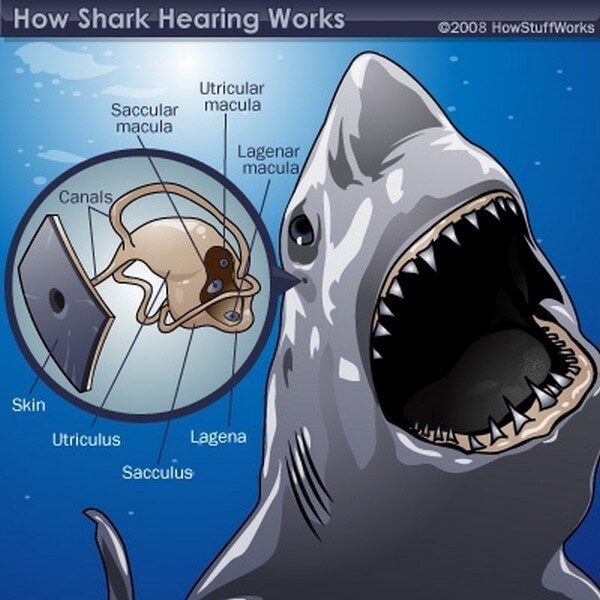The Harley Quinn animated series on the DC Universe app is one of the streamer’s bright spots.
It’s foul-mouthed, hyper-violent lead character is pretty much everything you’d want her to be, and her band of fellow villains are, well, equal parts messed up and weird and fun. If you grew up on the original Batman: The Animated Series, this is very much the “hard R” rated version of that Gotham and all of its denizens, and man…it’s something.
We’re not recommending it as an educational show, so please do not show it to anyone you wouldn’t take to see an R-rated movie. Our lawyer charges us a lot, so please don’t.
And anyway, this isn’t a review or critique site, we’re all about the science. So let’s get to the point of what we’re talking about: shark ears.
In the latest episode (Season 2, Episode 3, “Trapped”) the gang tries to break into Mister Freeze’s ice fortress and can’t. Figuring out how to kick starts the plot for the rest of the episode, but we’re not talking about that either. We’re talking about King Shark wearing ear muffs at the start of the episode.
King Shark (created by Karl Kesel and Tom Grummet back in 1994 for the Superboy comic series that sprang out of the Death of Superman event) is exactly what he looks like – a humanoid shark. A version of him has appeared in the CW’s The Flash, and is set to appear in James Gunn’s The Suicide Squad sequel in 2012 – so understandably, his personality is kind of all over the place in his different appearances, from shark god to dark matter victim to guy just trying to get by in Harley Quinn.

King Shark’s early days. Hey, it was the ’90s. Look at this cover while listening to Backstreet Boys, and it all makes sense. (c) DC Comics

King Shark has gone through some changes over the years in the comics, and OH MY GOD IS NO ONE ELSE FREAKED OUT BY HOW HE’S HOLDING THE BOOK!?! WHY? WHHHYYYY?!? HE’S LOOKING AT THE WALLS! (c) DC Comics

For his appearance on The Flash, King Shark found a trainer, and embraced creatine and nutritional supplements (c) Warner Bros and CW

The most recent version of King Shark, as seen as a lovable bad guy (who eats people) in Harley Quinn (c) DC Comics, Warner Bros
But again – ear muffs?
Yeah ear muffs. Why?
Because sharks have ears.
Okay – some clarification. Sharks do not have outer, or external ears like we do, their ears are all inner. They do have two small pores on either side of their head, near their eyes and towards the top of their body. The pores connect the mechanism of the sharks’ inner ear to the outside world.
Like us, sharks have three fluid-filled semicircular canals that help it orient itself in three dimensions, detect gravity and acceleration. Sharks also have four otolithic (“ear stones”) organs or maculae – the sacculus, the lagena, the utriculus and the macula neglecta. Similar to humans, sharks have bundles of sensory hair cells within the inner ear that fire nerve signals in response to being moved thanks to changes in the fluid’s pressure.

A close up on the where’s and hows of shark ears, from the always awesome, How Stuff Works (c) How Stuff Works
Think of it like this – when the movement of prey in the water minutely changes the pressure near the shark, the small “hairs” in the organs bend, which trigger nerve impulses that travel to the shark’s brain and signal that there’s something nearby.
As for hearing sounds, it’s thought that sharks “hear” low-pitched, or low-frequency sounds the best, and can hear sounds ranging from 10 Hz to 800 Hz, and respond strongly to sounds between 350-400 Hz (humans can hear 20 Hz to 20,000 Hz). Just a reminder – sounds are just pressure waves, or vibrations within a medium and the unit of frequency, hertz measures disturbances per second – 350 Hz = 350 pressure waves per second. Also, if the particles of that medium are closer together, then the sound will travel faster. That’s a quick way of saying that sound travels faster in water than it does in air. Sound is a definite tool in the hunting toolbox for sharks.
But it might not be the same for everyone – some research has pointed out that the inner ear anatomy of sharks can be sorted into four distinct groups, based largely on the sharks’ feeding behavior. The research suggests that sharks such as Great Whites and other active predators may have slightly different inner ear systems than those which are benthic (bottom-dwelling and feeding) foragers that perhaps would not need as sophisticated inner ear system.
So that’s sharks in our world – yes, they have ears. Yes, the ears work to tell the shark up from down, fast vs. slow and generally, if something is splashing around or making (low pitched) noise nearby.
As for King Shark in Harley Quinn’s world? That’s anatomical playtime – a vertical shark would’ve long been used to the fundamentally different native orientation compared to when it was in the water, but hearing…there’s a problem. Again – just all speculating, not wanting to be a funkiller…
Despite his ears being built and responding to a different frequency, King Shark would be able to hear his teammates just fine. The average frequency of human voices is between 85 – 180 HZ for a male, and 165 – 255 Hz for a female, well within his range. He wouldn’t enjoy as broad a swath of music, due to occasional high frequencies, and he’d have to depend upon his pals to point out when they hear sirens. Most sirens and alarms fall into the range between 1000 and 3000 Hz – the zone where human hearing is at its most sensitive. King Shark would also be a lousy babysitter, thanks to the high pitch of baby’s cries.
But if you’re using King Shark as a babysitter, you’ve clearly made some bad choices along the way, and maybe having a carnivorous shark watching your tender baby isn’t the worst of them?
Oh – wait – before we’re done…why earmuffs?
He’s got little pores that open to his inner ears, roughly near the spots on his head that the ear muffs covered. Getting cold air down in there, and chilling that inner ear fluid might just give him the worst ice cream headache.
We’re going to call this one on the side of the fiction having a bunch of truth to it, and that humanoid sharks should wear earmuffs in cold weather.

That is one miserably cold King Shark, right there, Harley Quinn. (c) DC Comics, Warner Bros
Oh yeah, and King Shark is most likely only partially warm-blooded (like Great Whites and Makos) thanks to the heat generated by their muscles when moving, but he’s just standing around here, so yeah, we’re betting a cold King Shark as we see in Harley Quinn is a miserable King Shark, for any number of reasons.







